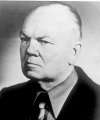Roberts Gaigals
| Roberts Gaigals | |
|---|---|
 Roberts Gaigals in the 1970s | |
| Born |
16 March 1913 Twer, Russian Empire |
| Died |
15 April 1982 (aged 69) Riga, Latvian SSR |
| Allegiance | |
| Service/branch |
|
| Years of service |
|
| Rank | Waffen-Obersturmführer |
| Unit |
|
| Commands held | 6th Company, 42nd Waffen Grenadier Regiment |
| Battles/wars | World War II |
| Awards |
Knight's Cross of the Iron Cross
|
Roberts Gaigals (born 16 March 1913, Twer, Russian Empire – died 15 April 1982, Riga, Latvian SSR) was a Waffen-Obersturmführer (First Lieutenant) in the Latvian Legion during World War II. He was awarded the Knight's Cross of the Iron Cross, which was awarded to recognize extreme battlefield bravery or successful military leadership by Nazi Germany during World War II.
Biography
The son of Latvian emigrants, Gaigals was born in Tver, in the Russian Empire. After 1920, the family returned to independent Latvia, and he studied at a commercial school in Riga.
In 1936 he was drafted into Latvian army, where he served in 9th Rēzekne infantry regiment. In 1937 he graduated from his training as a non-commissioned officer and was promoted to the rank of corporal. He entered the Latvian military academy in 1938 and graduated in July 1940, when Latvia was already occupied by the Soviet Union. He was promoted to lieutenant and served in a Pioneer regiment. Gaigals was still serving as an officer in Pioneer units when the Latvian army was incorporated into the Red Army. He deserted from the Red Army after Operation Barbarossa started in 1941.
He enlisted as an officer in the Latvian Legion after the formation of that unit in 1943. In May 1944 he was awarded the Iron cross II class; in July he received the Iron cross I class. Waffen-Obersturmführer Gaigals was the commander of the 6th Company, 42nd Waffen Grenadier Regiment, 19th Waffen Grenadier Division of the SS (2nd Latvian), when he was awarded the Knight's Cross on 5 May 1945.[1][2][lower-alpha 1] After the German capitulation in the Courland pocket, Gaigals entered Soviet captivity. He was sent to the Far East, Magadan. Gaigals returned to Latvia in 1954. He died in Riga on 15 April 1982.
Notes
- ↑ Gaigals' nomination had been finalized by the Heerespersonalamt (HPA—Army Staff Office) and was ready for signature by the end of the war. According to the Association of Knight's Cross Recipients (AKCR) the award was presented in accordance with the Dönitz-decree. This is illegal according to the Deutsche Dienststelle (WASt) and lacks legal justification. The presentation date is an assumption of the AKCR.[3]
References
Citations
- ↑ "frontkjemper".
- ↑ "axis.history.factbook".
- ↑ Scherzer 2007, pp. 131–132.
Bibliography
- Fellgiebel, Walther-Peer (2000) [1986]. Die Träger des Ritterkreuzes des Eisernen Kreuzes 1939–1945 — Die Inhaber der höchsten Auszeichnung des Zweiten Weltkrieges aller Wehrmachtteile [The Bearers of the Knight's Cross of the Iron Cross 1939–1945 — The Owners of the Highest Award of the Second World War of all Wehrmacht Branches] (in German). Friedberg, Germany: Podzun-Pallas. ISBN 978-3-7909-0284-6.
- Mitcham, Samuel W (2007). Retreat to the Reich : the German defeat in France, 1944. Mechanicsburg, PA: Stackpole Books. ISBN 978-0-8117-3384-7.
- Mitcham, Samuel W (2007). The German Defeat in the East, 1944–45. Mechanicsburg, PA: Stackpole Books. ISBN 978-0-8117-3371-7.
- Scherzer, Veit (2007). Die Ritterkreuzträger 1939–1945 Die Inhaber des Ritterkreuzes des Eisernen Kreuzes 1939 von Heer, Luftwaffe, Kriegsmarine, Waffen-SS, Volkssturm sowie mit Deutschland verbündeter Streitkräfte nach den Unterlagen des Bundesarchives [The Knight's Cross Bearers 1939–1945 The Holders of the Knight's Cross of the Iron Cross 1939 by Army, Air Force, Navy, Waffen-SS, Volkssturm and Allied Forces with Germany According to the Documents of the Federal Archives] (in German). Jena, Germany: Scherzers Miltaer-Verlag. ISBN 978-3-938845-17-2.